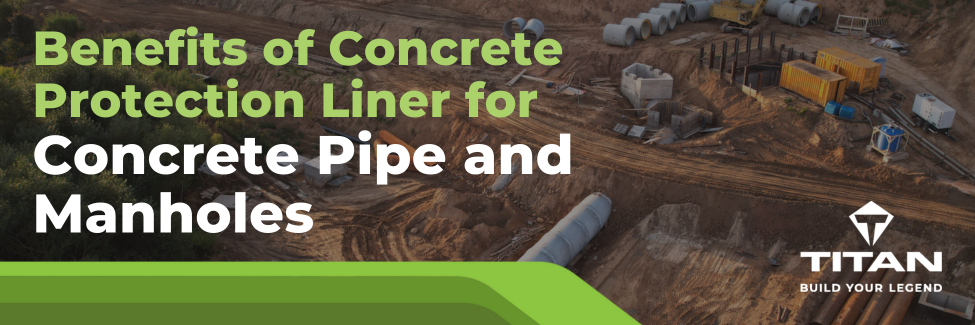Most concrete protection technologies for municipal wastewater systems are expensive and have a short life span. The spray coatings commonly applied require preparation of the concrete prior to application and are not designed to last the concrete’s life.
Concrete Protection Liner (CPL) is a high-density polyethylene (HDPE) geomembrane with anchors that embed into the concrete pipe, manhole or structure. It’s been in use around the world for over 40 years. The concrete cures around the anchors, making the liner a permanent part of the structure that never needs to be reapplied. The design life is the life of the structure, without future replacement or maintenance costs.
The result is permanent concrete protection against microbial induced corrosion (MIC), hydrogen sulfide attack, abrasion, and inflow and infiltration (I&I).
Applications Include:
- Wastewater Collection and Transmission Systems:
-
- Pipe, manholes, chambers and structures
- Wet wells and lift stations
- Municipal tunnels
-
- Water Treatment Plants:
-
- Tanks
- Digesters
-
- Industrial Wastewater Collection Systems:
-
- Sumps
- Tanks
- Manholes with high temperature, high abrasion, or highly corrosive media
-
- Industrial concrete storage tanks
- Agricultural Digesters
The CPL Advantage
Unlined concrete is very porous and allows for bacteria to harbour and colonize in the concrete, creating microbial induced corrosion (MIC) and hydrogen sulfide attack. Concrete Protection Liner is high density polyethylene (HDPE) geomembrane. It provides a smooth surface over the concrete that is not porous. As a result, the bacteria cannot colonize or reach the concrete, eliminating the opportunity for MIC and hydrogen sulfide attack. Some additional benefits of CPL include high chemical resistance, abrasion resistance, and increased flow characteristics for the wastewater.
Backpressure Resistance
Almost all piping systems and many manholes will develop leaks over time. Those leaks occur behind the liner and put backpressure onto the liner. The deeper the pipe or manhole is situated underground; the more pressure and stress is put on the liner due to groundwater. If a liner fails, regardless of what technology of liner, it is almost always from backpressure.
Until CPL, spray coatings were the most common way to deal with corrosion. The problem with spray coatings is they rely on a surface bond, and they are not structurally embedded into the concrete. As a result, they cannot handle significant amounts of backpressure and often come off the pipe or manhole.
When CPL is used, the concrete cures around the studs, ensuring that the liner remains securely in place. The liner then becomes a permanent part of the concrete, lasting the life of the structure.
The durability and effectiveness of these anchored liners make them a superior choice for both new construction and rehabilitation projects.
Concrete Protection Liner for Manholes
Manholes face two major issues: corrosion and infiltration and inflow (I&I). To combat these, Concrete Protection Liner (CPL) is embedded into the concrete. The vertical segments that make up the shaft of the manhole, called riser sections, are welded together in the field. This process creates a continuous, sealed barrier that fully protects the manhole from both corrosion and I&I.
The most common sealants for these issues are typically low-grade rubber or mastic-type materials that can become brittle, crack with age, or degrade from gas exposure, particularly under the pressure of groundwater in deep manholes.
Manholes are at high risk of costly damage, especially lower into the ground where backpressure increases. How does CPL address these challenges?
-
- CPL is designed to go deep into the water table with no risk of infiltration.
- The result is a corrosion free and infiltration-free manhole with no opportunity for leaks.


Concrete Protection Liner for Wastewater Pipes
CPL is used in precast RCP pipe, pressure pipe, and micro tunnel pipe. After the pipes are installed a cap strip is welded into place, joining the CPL from pipe to pipe. The liner then protects the pipe from corrosion, infiltration, and exfiltration. CPL has a minimum expansion / elongation rate of 300% before failure as compared to an average expansion rate of 4% to 8% with epoxy coatings. This means it can handle differential settlement, deflection, and seismic events while still providing protection to the concrete.
Find out how we helped a client install a force main and gravity sewer system to carry sewage from a pumping station to a Water Pollution Control Centre in this case study.
Work with Titan
At Titan, we’re more than providers of solutions. We’re a highly responsive team who can help you through every stage of the design and installation process. We have installed more CPL than anyone else in North America.
Interested in learning about how CPL could work for your project? Schedule a Titan Tech Talk or look out for our annual Concrete Protection University event. Fill out the form below to get in touch with our team.



